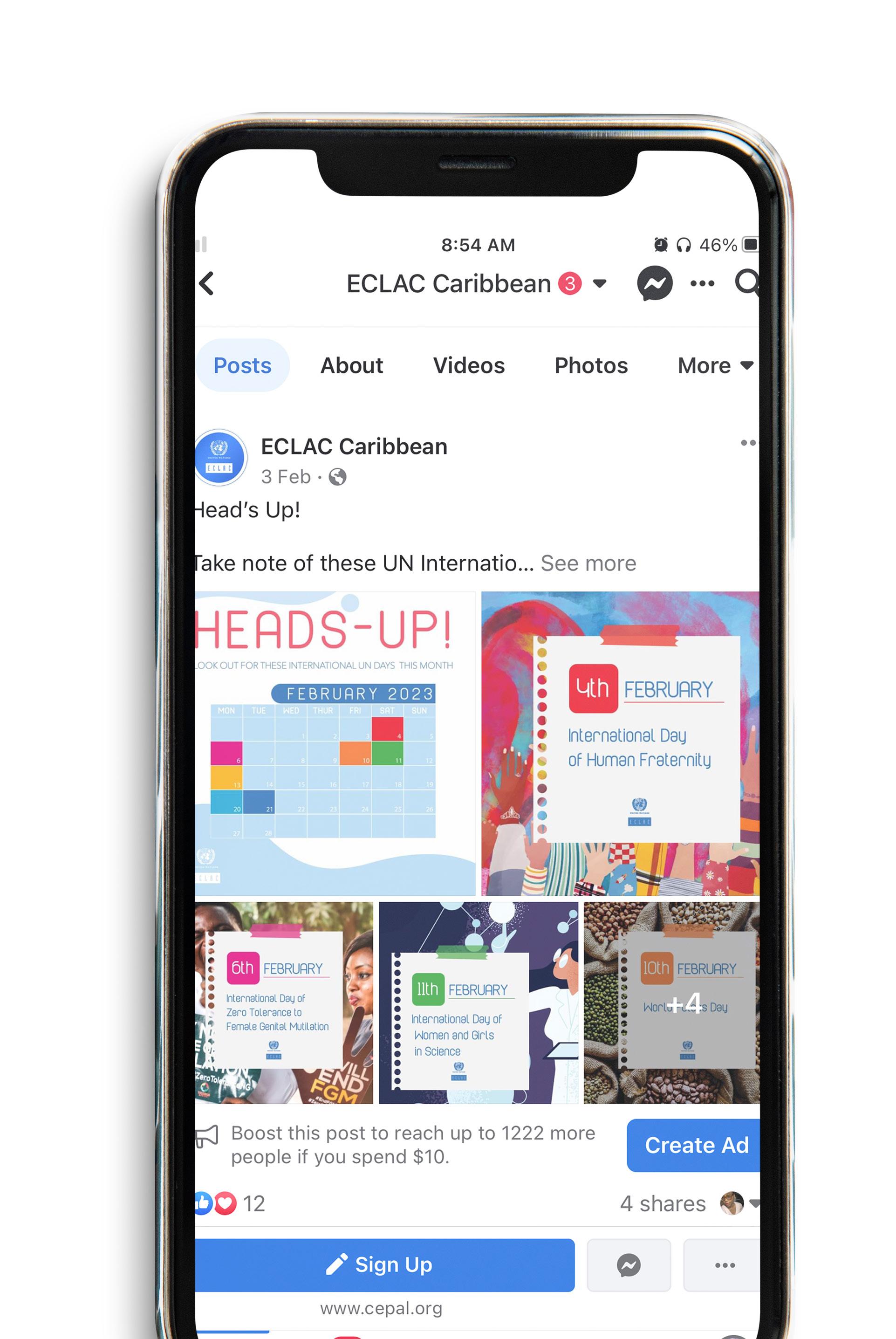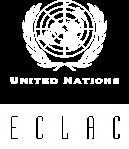ECLAC Caribbean workshop reaches
Improving broadband quality

AND AFFORDABILITY IN THE CARIBBEAN
AGREEMENTS IN PREPARATION FOR MAJOR SIDS MEETING Pirates of
the Caribbean
A HUMMINGBIRD SPECIAL FEATURE
Volume 10 - Issue 3
About us
Issued on a monthly basis, The Hummingbird offers insights into the latest projects, publications, technical assistance missions and research carried out by ECLAC Caribbean. In addition to these, sneak previews are provided of the most salient upcoming events, alongside enriching followups to previously covered issues. With a view to featuring a variety of facets of Caribbean life and lifestyle, The Hummingbird also zooms in on cultural activities and landmark occurrences through an eye-opening regional round-up.

EDITORIAL TEAM
Editor: Jabari Fraser

Copy Editor: Denise Balgobin

Proof Reader: Veera Deokiesingh-Fraser
Publication Design: Liseanne Martin-Subero
Please see our contact details on the back cover of this magazine.
A HUMMINGBIRD FEATURE:
Pirates of the Caribbean, A Hummingbird Special Feature ECLAC workshop on census data dissemination using REDATAM Major upgrades at Montego Bay Airport 4 6 10 14 17 4 10 9
ECLAC Caribbean workshop achieves agreements in preparation for major SIDS meeting
Improving broadband quality and affordability in the Caribbean
International Days
7 April
World Health Day
21 April
World Creativity and Innovation Day
22 April
International Girls in ICT Day
23 April
World Book and Copyright Day
Upcoming Meetings


4 APRIL 2023
Joint ECLAC and ESCWA regional webinar on Prices: innovation and integration of statistical operations

12 APRIL 2023
Seminar-workshop on instruments for strengthening official statistics: code of good practice and peer review mechanisms
20 APRIL 2023
Parliamentary Summit on Climate Change and Just Transition in Latin America and the Caribbean
25 APRIL 2023
Sixth meeting - Forum of the Countries of Latin America and the Caribbean on Sustainable Development
ECLAC Caribbean workshop reaches
AGREEMENTS IN PREPARATION FOR MAJOR SIDS MEETING
In preparation for the upcoming fourth International Conference on Small Island Developing States (SIDS), scheduled to be held in May 2024 in Antigua and Barbuda, UN regional commissions serving small island developing states (SIDS) have been tasked with preparing regional reports on the status of implementation of the SAMOA Pathway on SIDS.
Information on these commitments was recently published by ECLAC Caribbean, as part of a report on a workshop on the preparation of reports for the 10-year review of the SIDS Accelerated Modalities of Action (SAMOA) Pathway (Samoa Pathway), which was held in December 2022.
Artie Dubrie, ECLAC Caribbean’s Coordinator of the Sustainable Development and Disaster Unit, explained in her opening address that the workshop was convened to discuss the regional plans for the 2024 meeting. “These include the steps and actions required to prepare the national and regional synthesis reports on the implementation of the Samoa Pathway. These reports would serve as inputs to the regional preparatory meeting which will be held later this year.

4|The Hummingbird
She further outlined the workshop objectives, including (i) Agreement that the overarching Samoa Pathway Monitoring and Evaluation Framework to be used in the preparation of regional synthesis reports, (ii) Endorsement of the methodological approach to be used for the preparation of the national and regional synthesis reports, (iii) Endorsement of the outline/structure for the review of Samoa Pathway implementation reports, and (iv) Agreement on the timeline for the preparation of national and regional synthesis reports.
IN addition to ECLAC personnel, there were representatives from the UN Economic Commission for Africa (ECA), Economic and Social Commission for Asia and the Pacific (ESCAP), and Economic and Social Commission for Western Asia (ESCWA). Other UN agencies represented, included the Department of Economic and Social Affairs (DESA), Office of the High Representative for the Least Developed Countries, Landlocked Developing Countries and Small Island Developing States (UN-OHRLLS), and Development Coordination Office (DCO).
Saint Lucia’s visitor form
IS GOING DIGITAL
Anya Ihsan Thomas, Economic Affairs Officer, of DESA’s SIDS Unit, indicated that DESA and UN-OHRLLS were the two UN entities responsible for providing substantive support to the preparatory processes for the fourth International Conference on SIDS. She acknowledged the work of the regional commissions supporting SIDS in providing leadership, capacity development, and analytical and policy advisory services.
Saint Lucia is digitizing its embarkation and disembarkation form for visitors, in what is hopefully part of a broader Caribbean trend. The island has announced that, effective 1 March 2023, the immigration form for visitors is going digital.

The new electronic form will replace the written form and “significantly reduce the processing time of arriving passengers,” according to a statement from the Saint Lucia Tourism Authority.
The form should be submitted prior to arrival in Saint Lucia. If visitors have not completed the form digitally before arrival, they will have to fill out a written form.
She also outlined in detail the expected outputs and timelines in preparation of the Conference. These included three SIDS regional consultations and an interregional meeting expected to take place between July and September 2023.
“We continuously strive to secure our borders and provide quality service to travelers at our points of entry, while protecting the safety and security of our nationals, visitors, and business associates with a reliable immigration system. In advancing our seamless entry process, the written form will be phased out as of 12 April 2023,” said Sean Alexander, Assistant Superintendent in Charge of the Department of Immigration in Saint Lucia.
The Hummingbird |5

6|
IN THE CARIBBEAN Improving broadband quality and affordability
The Hummingbird
In a digitally transforming world, digital inclusion is becoming increasingly important to social inclusion and sustainable development. Affordable access to broadband is an essential precondition to digital inclusion. Internet quality, as measured by speed and other indicators, is also important, as digital inclusion is ultimately about ensuring equal access to the benefits and opportunities offered by digital technologies and the internet.
A new policy brief from ECLAC Caribbean provides insight into internet speed and affordability across the Caribbean, and offers some recommendations for policymakers working with digital technologies and telecommunications.

The Hummingbird |7
read more
continued from page 7
IMPROVING BROADBAND QUALITY AND AFFORDABILITY IN THE CARIBBEAN

As more human cultural, social and political events are conducted online, the cost of exclusion from digital spaces increases, which can lead to inequality and marginalization. Digital and social inclusion are also inextricably linked, and the digitally excluded tend to be those that are the most marginalized in society.
For example, people with disabilities, who may be socially
excluded and lack access to work and education, could greatly benefit from access to the Internet and accessible digital technologies. However, as a consequence of their social exclusion, they may have low incomes and not be able to afford such access, barring them from accessing communication tools, information, services and entertainment, among others. This exclusion from the digital realm would then compound
the marginalization they already experience in the physical world.
ECLAC’s new policy brief analyses some available data related to this topic. It also identifies some possible drivers of affordability in the Caribbean and provides recommendations to policymakers on what changes might have most significant impact.
The recommendations include
8|The Hummingbird
developing a national broadband plan, with guidelines for infrastructure funding or subsidies clearly defined, the subsidization of broadband access for underserved populations, and the promotion of free or low-cost public internet access.

Another issue addressed in the brief include the average broadband speed in the Caribbean, which has increased dramatically in recent years. However, significant disparities of such speed remain among countries. There are also significant disparities among countries related to cost of access to fixed broadband. In most countries of the subregion, the cost of fixed broadband exceeds set international targets, in
some cases significantly, raising concerns for entities responsible for digital inclusion.
Improving internet quality, including increasing speed, is therefore important to ensure that people can fully benefit from internet access, which is key to digital inclusion. Internet quality can be measured in several ways, including upload speed, download speed and latency. These indicators are frequently measured by telecommunications companies but can also be measured by consumers via private entities.
Digital inclusion is becoming increasingly important as the digital transformation of the world and the subregion accelerates.
Two challenges that would need to be addressed to advance digital inclusion are access to high-quality broadband and affordability. The development of effective, evidence-based policies, and their implementation and enforcement, are therefore essential to tackle the drivers of affordability in the Caribbean.
Further collaboration at the subregional level and targeted research are needed in order to identify which drivers are most relevant to the Caribbean, and may lead to increased internet quality and affordability in the shortest possible delay in all countries.
Find the full policy brief at
The Hummingbird |9


special 10|The Hummingbird
With all due deference to Captain Jack Sparrow and the Pirates of the Caribbean franchise, there’s a far richer (and bloodier) vein of real pirate history and lore running through the islands of the Caribbean.

While some of it has literally sunk into the sea, there’s still plenty of opportunity for swashbuckling travelers to walk in the boots of some of the Caribbean’s most infamous buccaneers.
Enjoy this special feature from the Hummingbird!
The Hummingbird |11
The 69-square-mile island of Tortuga, which lies off the north coast of Haiti, traded hands between the French, Spanish, and English several times during the 17th century. When it wasn’t being occupied or invaded by one navy or the other, it became the haven for the Brethren of the Coast, an alliance of pirates and privateers led by legendary pirate Henry Morgan.
Today, the island is still associated with dark commerce, as a departure point for smuggling trips taking Haitians to the shores of south Florida. Tortuga is seen as having huge potential for tourism — Royal Caribbean Cruises was even thinking of building a cruise port there about a decade ago — but the ongoing turmoil in Haiti has largely kept visitors away.
Who says piracy can’t be fun? Every November, the Cayman Islands celebrates Pirates Week with mock pirate invasions, costume parties, food festivals, and more. The whole event has become so popular that it has been expanded into a sevenweek-long Pirate Fest. In a way, the hospitality mirrors some of the things that attracted the pirates to the remote Caymans in the first place: fresh water, turtle meat, and wood.
Blackbeard, who apparently was everywhere (and nowhere) in the Caribbean, occasionally ported here, as did fellow pirate Edward Low, a particularly nasty piece of work known for torturing prisoners to death.

Port Royal was once said to be a notorious pirate town, on the once thin stretch of land known as the Palisadoes at the outer edge of Kingston Harbour. At one time the largest and richest city in the Caribbean, Port Royal was a favourite hideout for pirates, thanks to its close proximity to the trade routes, where they found merchant ships and the Spanish Main to prey upon.
By the mid-1600s, the swelling population of pirates and privateers based here made Port Royal — dubbed the “Sodom of the New World” — the de-facto capital of seagoing pillage in the Caribbean. However, a devastating earthquake and tsunami in 1692 destroyed two thirds of the city, with much of it falling into the sea. Following a series of subsequent fires and hurricanes, Port Royal was largely abandoned. Today, visitors to Kingston can tour Fort Charles, which dates from the 17th century and includes some relics retrieved from Port Royal, and snorkel over the ruins of the sunken city, which is under consideration as a UNESCO World Heritage Site.
12|The Hummingbird
In its pirate heyday, Nassau was nearly as notorious as Port Royal. Once home to more than a thousand pirates, including the infamous Edward Teach, a.k.a. Blackbeard. New Providence Island became known as the capital of the Pirate’s Republic in the 17th and early 18th century, until the British Royal Navy attacked the island and chased off or rounded up the resident pirates. The end of Nassau’s pirate reign was marked in 1718 by a mass execution of pirates in the town square.
The Pirates of Nassau (tour company) does a fine job of detailing the island’s brigand past and features several immersive displays, including a recreated quayside with a pirate ship at anchor. Most of Nassau’s surviving historic sites, including its three forts, The Graycliff hotel and the famous Queen’s Staircase, were built after the reign of pirates ended. But the Deanery House on Cumberland Street is believed to have been built in 1710.
Pirates notoriously plied the waters of the British Virgin Islands (BVI), and Normal Island is actually named for a pirate, as is Bellamy Cay and Sir Francis Drake Channel. The island also was one of the few places in the Caribbean with a documented history of having been a repository for buried treasure (stashed there by the mutinous crew of a Spanish ship in 1750), and served as inspiration for Robert Louis Stevenson’s classic book, Treasure Island.
BVI visitors can visit Norman Island, dine at a beach restaurant, and hike to the highest point of the island. The hottest action is said to be just offshore, where the party boat, Willy T, sits at anchor in Norman Bight. (An earlier iteration of the boat, sunk during a hurricane, is a popular dive spot inhabited by a skeleton crew of pirates.)
Blackbeard made his smoky presence known far beyond Nassau: he also spent time with his band of brigands on Saint Thomas. Blackbeard’s Castle, a 40-foot-tall hilltop tower and originally called the Skytsborg, was erected here by the Danes in 1679. It’s reputed that Blackbeard climbed its 99 steps to scan the horizon for approaching ships.
The list of pirates who operated in the Virgin Islands is long, including such legendary captains as William Kidd, Jean Hamlin, Stede Bonnet, Tempest Rogers, Bartholomew Sharp, and Black Sam Bellamy. Popular with visitors and residents is the Pirate Treasure Museum, which includes a collection of real sunken treasure recovered by marine archaeologists.
As part of the US Virgin Islands, Saint Croix is known for its Danish history. But French pirates were thought to be operating from the island as early as 1522, which not only predates the arrival of the Danes but would make Saint Croix one of the first pirate colonies in the Caribbean.
The site of the Buccaneer resort was once the home of privateer Jean Martel, and the remains of several pirate ships sunk by the British Navy in 1716, lie in the waters of Salt River Bay.

The fierce Kalinago people inhabiting Dominica kept the island free of European conquest well after most other Caribbean islands had succumbed, making it an attractive place for pirates to hide out, repair their ships, and trade with the local inhabitants.
Dominica remained largely overlooked by visitors until the Pirates of the Caribbean movies were filmed in several locations during the early 2000s, and visitors can tour sites like the Titou Gorge, which can be seen in the movie franchise.
The Hummingbird |13
ECLAC workshop on census data
DISSEMINATION USING REDATAM
National population and housing censuses are a key source of demographic and social statistics, and they also provide data for the calculation of many other social and economic statistics. They are therefore important to national statistical systems and, by extension, to national development planning, policymaking, and monitoring of economic, social and environmental resilience.
A recent workshop on REDATAM was organized by ECLAC Caribbean in Saint George‘s, Grenada, to provide support to Barbados and Grenada, in making their 2011 census data available
online. It also served to prepare these two statistical offices to make their 2020 census round data available online as soon as possible.
Participants included statisticians and IT Officers from two participating organizations, which were the Central Statistics Office of Grenada and the Barbados Statistical Service. They received introduction (or in some cases reintroduction) to the REDATAM software; and provided support towards finalizing web applications for the two countries’ 2010 census round datasets.
Since the 2000 round of population and housing censuses, ECLAC has sought to make Caribbean census data more widely available to policymakers, researchers and the public by promoting and supporting the use of the Retrieval of Data for Small Areas by Microcomputer (REDATAM) software for online dissemination of census data.
REDATAM is a tool for census dissemination, developed and supported by ECLAC. In the pre-Internet era, it served as a tool for census data processing and tabulation, before it was developed to facilitate online

14|The Hummingbird
access to census and survey microdata.
REDATAM has been used primarily to provide access to census data sets, although it can also be used for survey data sets such as living conditions surveys. ECLAC underscores that improved online access to these data sets can only encourage their use in research, development planning and evidence-based policymaking.

ECLAC held 13 REDATAM workshops in the Caribbean
between 2008 and 2022. These were a combination of regional and national workshops, and included two online versions in 2020 and 2021 when face-to-face meetings were restricted.
To date, nine member States have made data from the 2010 census round available online through REDATAM; Antigua and Barbuda, Aruba, Belize, Cayman Islands, Jamaica, Montserrat, Saint Lucia, Saint Vincent and the Grenadines, and Trinidad and Tobago. This is an improvement over the 2000 round
when four countries implemented REDATAM.
Providing easy access to census data is one of the best ways that a statistical office can encourage wider use of the data for decision making and development planning. Caribbean statistical offices disseminate census data in various forms, for example census reports, REDATAM applications, and through the release of anonymized microdata.
The Hummingbird |15
Anguilla opens
NEW FERRY TERMINAL

The new-look ferry terminal in Anguilla has officially opened its doors. The transformed Blowing Point Ferry Terminal recently welcomed its first passenger, via the new entry point for the vast majority of travelers that come to the island.
The sleek, modern facility replaces what had been a decidedly cramped, uncomfortable experience for ferry passengers.
In a nice touch, a prominent wall in the terminal features some of Anguilla’s most renowned sporting heroes, from WNBA player Mikiah Herbert Harrigan to cricket star Omari Banks.
The terminal receives both regularly scheduled ferry service from Saint Martin and private charter service from St Maarten.
Of course, the most glamorous way to arrive in Anguilla remains flying on Tradewind Aviation from San Juan.
16|The Hummingbird
Major upgrades at
MONTEGO BAY AIRPORT
The Sangster International Airport in Montego Bay, Jamaica is in the midst of a full-scale modernization project. The plan, officials say, is to transform the busy airport into a “worldclass facility.”
That includes a US $70 million runway expansion, the opening of the first-ever Bob Marleybranded restaurant, the expansion of the immigration hall and departure lounge and the upgrade of outbound security. It follows an alreadycompleted revamp of the airport’s duty free offering.
“When the dust is settled on all of these projects, we are talking about [comparisons with] Heathrow, Atlanta, JFK, Qatar, Dubai… you name the airport,” says Delano Seiveright, senior strategist and advisor in the Ministry of Tourism.

“When guests fly [into Jamaica] from wherever they are coming, there will be that ‘wow’ factor.
MBJ Airports Limited must be commended for the tireless work and the vision to make this possible. That Bob Marley One Love restaurant and the runway extension will be something else.”
Jamaica is seeing sizzling tourism numbers this year, as Montego Bay hopes to eclipse the record 4.7 million passengers that used the airport back in 2019, before the pandemic.
“There are other works being undertaken to modernize the Sangster International Airport and provide a seamless experience for passengers,”
said Shane Munroe, chief executive officer of the airport.
Another project will see the construction of a lounge for air-to-sea cruise passengers, providing a dedicated arrivals
space for landing and then a coach transfer to the cruise ship pier. The runway expansion project is on schedule for completion by June of this year, Munroe said.
Sangster Airport is also getting greener, with the installation of a MWac solar plant that has reduced the airport’s reliance on the national grid by 11 per cent.
Even better? There are also plans for new biometric projects. That would mean “passengers can check in offsite, tag their bags, and use their identity to pass through checkpoints seamlessly and efficiently,” said Sharon HislopHolt, commercial business development and marketing manager at the airport. “The goal is that passengers spend the least possible amount of time in queues so that they can enjoy our facilities with the least stress possible.”
The Hummingbird |17
THE KITCHEN
pirate cake
4 servings
What you will need:
• 200g milk chocolate
• 6 eggs (separated)
• 250g butter (melted)
• 200g sugar
• 8 Tbsp. milk
• 8 Tbsp. flour
• 8 grams baking powder
• 1 pinch of salt
How to Make it:
Step 1: Preheat the oven to 180 degrees celsius.
Step 2: Beat the egg yolks and sugar until pale and fluffy.
Step 3: Add melted butter and whisk until incorporated.
Step 4: Melt the chocolate with the milk and add to egg yolk mixture.

Step 5: Add flour, baking powder and salt, stir to combine.
Step 6: With an electric mixer, beat the egg whites until stiff.
Step 7: Add beaten egg whites to cake batter, folding gently with a rubber spatula.
Step 8: Transfer batter into a well-greased cake pan.
Step 9: Bake for 25 minutes.
Step 10: Let cool completely before unmoulding, then decorate.
18|The Hummingbird

The Hummingbird |19





CLICK HERE OR SCAN THE QR CODE TO VISIT OUR WEBSITE... ECLAC Subregional Headquarters for the Caribbean, 1 Chancery Lane, P.O. Box 1113, Port of Spain, Trinidad and Tobago. MEDIA CONTACT Tel.: 1 868 224 8075 E-mail: eclac-media-pos@eclac.org CONTACT US
SOCIAL MEDIA





























